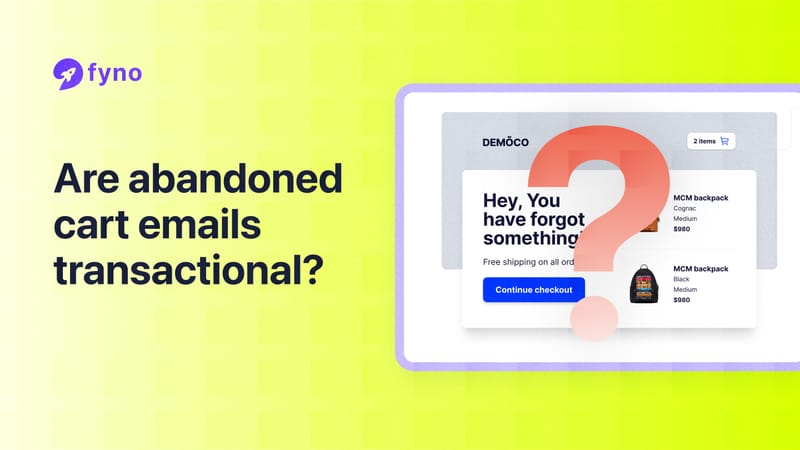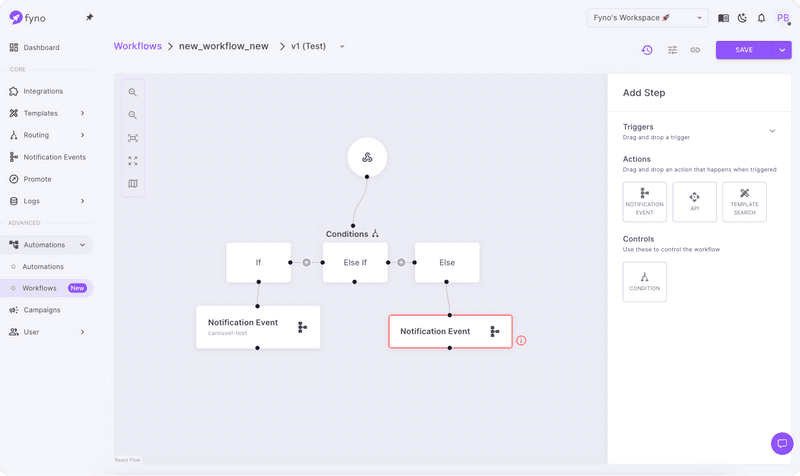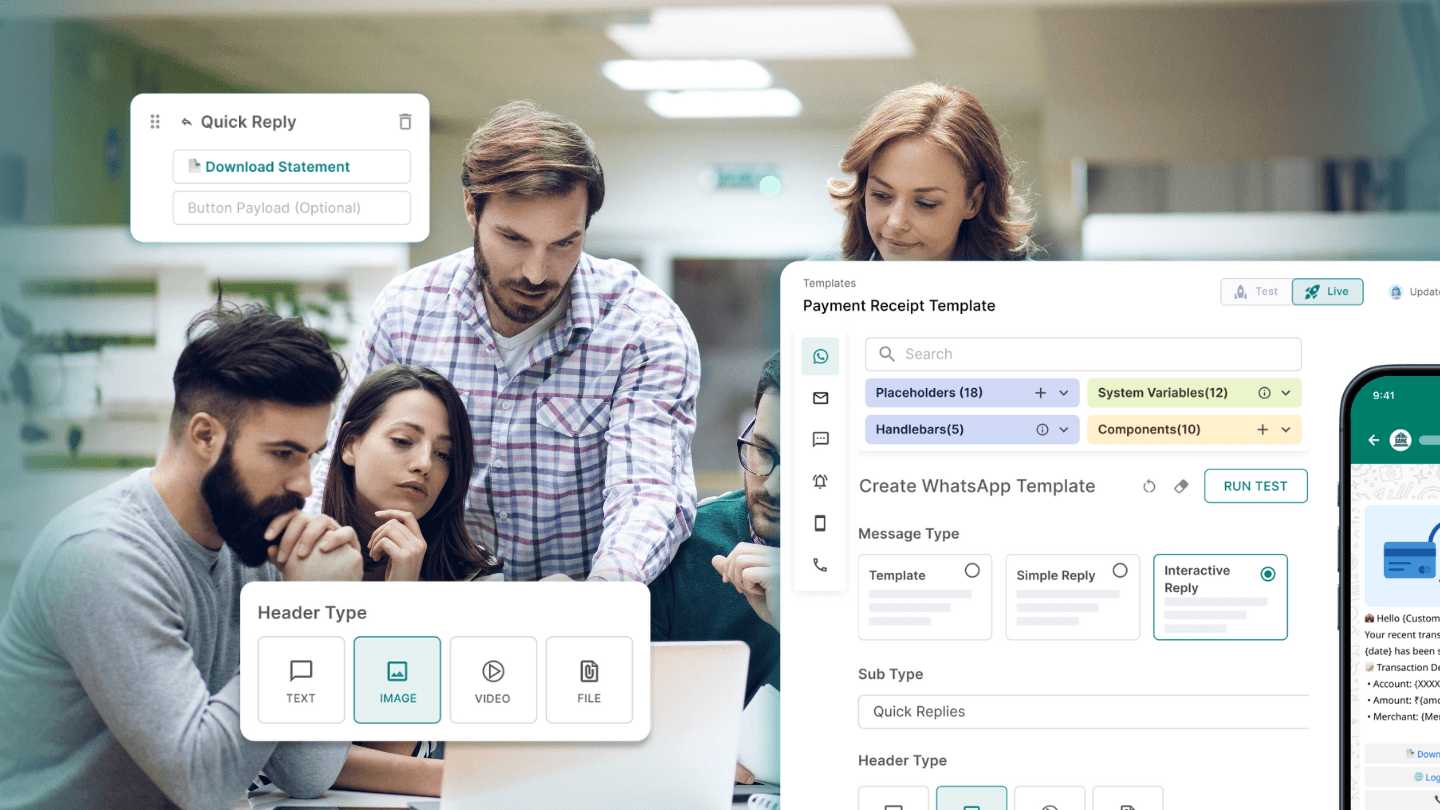Abandoned cart emails can be categorized as both transactional and marketing emails, depending on their content and intent. In the BFSI and logistics sectors:
Transactional: These emails are sent as part of a transaction that the customer has already initiated. For example, if a customer begins a loan application, the email reminding them to complete it is transactional. These emails focus on completing a process the customer started and often include essential information or next steps required to finalize the transaction.
Marketing: These emails can also serve a marketing function by encouraging customers to engage with the company’s products or services. They can highlight the benefits of completing the application or booking, offer incentives, and provide additional resources or contact information for assistance. This aspect aims to re-engage customers and drive them back to the transaction.

What are abandoned cart emails?
Abandoned cart emails are notifications sent to customers who initiate but do not complete a transaction. These emails remind customers of the items they leave abandoned in their shopping carts on an online store, aiming to encourage them to return and finalize their purchase.
In the BFSI (Banking, Financial Services, and Insurance) sector, these emails often address incomplete applications for financial products like loans, credit cards, or insurance policies. In logistics, they can remind clients about unfinished service bookings or incomplete shipment orders. These emails help recover potential losses by prompting customers to finalize their transactions.
How do abandoned cart emails work?
An abandoned cart email sequence is triggered by specific customer actions. For example:
BFSI: When a customer begins an online application for a loan but leaves before submission, an abandoned cart email strategy is used to remind them to complete the application. These emails may include a link to resume the application, a list of required documents, or an incentive to finish the process.
Logistics: If a client starts scheduling a shipment but doesn't complete the booking, an email reminder can encourage them to finalize their shipment details. These emails often highlight the benefits of completing the booking promptly, such as securing a delivery slot or availing of a discount.
Why do people abandon items in carts?
In the BFSI and logistics sectors, abandonment can occur for several reasons:
Complexity: The application, booking processes or unexpected shipping costs might be too complex or not appealing.
Lack of Information: Customers might need more information to complete the transaction confidently.
Distractions: Clients may get distracted by other tasks or obligations and forget to complete their transaction.
Technical Issues: Problems with the website or application can prevent customers from finishing their transaction.
Privacy laws and compliance
Understanding the legal landscape for abandoned cart automation, abandonment emails and abandoned cart messages is crucial, especially regarding compliance with privacy laws like GDPR and the ePrivacy Directive.
Compliance and privacy considerations
Abandoned cart emails, while essential for recovering potential lost revenue and sales, must comply with strict privacy regulations.
This means businesses can argue that sending abandoned cart emails to online shoppers is necessary for their marketing purposes, provided they follow a three-part Legitimate Interest Assessment: the Purpose Test, the Necessity Test, and the Balancing Test. This assessment ensures that the emails are necessary and do not override the recipient's rights and freedoms.
Purpose Test
Identify the legitimate interest: Clearly state that the goal is to recover sales by reminding customers of their abandoned carts.
Direct marketing context: Establish that abandoned cart emails serve as a direct marketing tool, which is a recognized legitimate interest.
Necessity Test
Assess necessity: Prove that abandoned cart emails are essential for achieving the marketing goal and that there are no less intrusive means.
Proportionality: Ensure the volume and frequency of emails are reasonable and directly linked to the purpose.
Balancing Test
Balance interests: Evaluate if the business interest in sending these emails outweighs any potential privacy impacts on customers.
Customer expectations: Ensure that customers would reasonably expect to receive these emails based on their interaction (e.g., adding items to a cart).
Transparency and opt-out: Clearly inform customers about data usage and provide easy opt-out options in every email.
General Data Protection Regulation (GDPR)
Under GDPR, businesses in BFSI and logistics can use legitimate interest as a basis to send abandoned cart emails. This involves demonstrating that the emails are expected by the customers, non-intrusive, and that they contain clear opt-out options. Transparent communication about how the data will be used is necessary to comply with GDPR.
Are abandoned cart emails GDPR compliant?
To comply with GDPR, businesses must ensure transparency in their data collection and usage policies. This includes clearly informing customers that their email addresses will be used for sending abandoned cart emails and providing an easy opt-out mechanism in every communication.
Sensitive Personal Data or Information, 2011 (SPDI Rules)
These rules, under the IT Act, 2000, govern the handling of sensitive personal data or information (SPDI) in India. While SPDI primarily includes information like passwords, financial information, and health data, businesses collecting email addresses for sending abandoned cart emails must ensure they follow reasonable security practices and obtain consent from users.
Companies must provide a privacy policy and notify individuals about the data collection, its purpose, and how it will be used.
Personal Data Protection Bill, 2019 (PDPB)
Though not yet enacted, the PDPB is set to bring comprehensive data protection regulations to India, akin to GDPR. The bill mandates explicit consent for processing personal data and grants individuals rights over their data, such as the right to access, correct, and delete their information. Businesses would need to ensure compliance by obtaining explicit consent for sending abandoned cart emails and providing clear opt-out mechanisms
ePrivacy Directive
The ePrivacy Directive complements GDPR and permits sending abandoned cart emails under a "soft opt-in" when customers have provided their email addresses during a transaction. These emails must relate to similar products or services and include a simple opt-out mechanism.
For example, a financial institution can send reminders about an incomplete loan application, provided the email focuses on that specific transaction and offers an easy way to unsubscribe.
California Consumer Privacy Act (CCPA/CPRA)
The CCPA and its amended version CPRA mandate that businesses provide transparency about data usage and offer opt-out options for abandoned cart email and communications. For sectors like BFSI and logistics, this means clearly informing customers about how their data will be used and ensuring compliance with requests for data deletion. Abandoned cart emails must include opt-out instructions and comply with any customer requests regarding their data.
CAN-SPAM Act of 2003
In the United States, the CAN-SPAM Act regulates commercial emails, including those sent by BFSI and logistics companies. These regulations require clear identification of the email as a solicitation, a physical postal address, and a prominent opt-out mechanism. Adhering to these guidelines ensures compliance and helps maintain customer trust
Strategies and best practices for abandoned cart emails
Creating effective abandoned cart emails is essential to recover lost sales and increasing revenue. Here are some proven strategies and best practices for abandoned cart email template.
Opt-In and Opt-Out Relevance
Ensuring customers are aware of the opt-in and opt-out options in your emails is crucial for maintaining a positive relationship. Allow customers to easily manage their email preferences, reducing the risk of them feeling overwhelmed and opting out entirely. Clear instructions on how to unsubscribe or change preferences should be included in each email, maintaining transparency and trust with your audience.
Abandoned cart email strategies that Work
Timely Follow-Ups: Send the first email within a few hours after cart abandonment, followed by subsequent emails at 24 and 72 hours. This timing can increase the chances of recapturing the customer's interest while the items are still fresh in their minds.
Personalization: Personalize emails with the customer's name, abandoned items, and tailored recommendations. This approach makes customers feel valued and understood. Personalized subject lines can also significantly increase open rates.
Creating Urgency: Use countdown timer, discount code, and limited-time offers on the checkout page to create a sense of urgency, encouraging customers to complete their purchases quickly. Highlighting that items are low in stock or that a discount is about to expire can be effective tactics.
Clear Call-to-Actions (CTAs): Ensure your CTAs are prominent and easy to understand. A single, clear CTA can increase clicks and conversions. For instance, phrases like "Complete Your Purchase" or "Reclaim Your Cart" are direct and action-oriented.
Engaging Copy and Design: Keep your email copy concise and engaging. Use a friendly tone that aligns with your brand's voice. Including high-quality images of the abandoned products and a straightforward layout can enhance the email's appeal.
Incorporate Social Proof: Adding customer testimonials, reviews, or social proof can reassure hesitant buyers about the quality and popularity of your products. This strategy leverages the psychological need for validation and can significantly boost conversions.
By implementing a few best practices, you can create abandoned cart emails that not only remind potential customers of their pending purchases but also provide compelling reasons to complete them.
Fyno's approach to abandoned cart emails
Fyno's innovative approach to abandoned cart emails integrates seamlessly with BFSI and fintech industries, offering a robust multi-channel notification system. By leveraging email, SMS, and push notifications, Fyno ensures that customers are reminded about their abandoned shopping carts through their preferred communication channel. This opti-channel strategy is particularly effective in reaching a diverse customer base and increasing the chances of cart recovery.
Omnichannel communication routing
Omnichannel routing ensures that BFSI and logistics companies can engage customers effectively by choosing the right communication channel based on customer preferences. For example, if a banking customer frequently interacts via mobile app notifications, an abandoned cart reminder for an uncompleted loan application form can be sent through this channel to prompt immediate action.

In logistics, if a customer prefers SMS updates, critical information regarding shipment adjustments or delivery confirmations can be sent via SMS, directly impacting the efficiency of delivery schedules and customer satisfaction.
This targeted approach minimizes disruptions and enhances the likelihood of transaction completion.
Template management
Effective template management is crucial for optimizing your email campaigns, particularly in sectors like BFSI and logistics where timely and personalized communication can greatly impact customer engagement. By leveraging customizable templates, businesses can efficiently handle abandoned cart scenarios by sending tailored reminders to customers.

This not only helps in recovering potential sales but also enhances the customer experience by making interactions feel more personal and less automated. Ensuring your templates are well-organized and easily accessible can significantly streamline your email marketing strategies, turning lost customers and abandoned carts into completed transactions.
Automated workflows trigger
Timely communication is critical to retaining customer engagement and completing transactions. Abandoned cart email examples are designed not just to market a product but to facilitate an incomplete transaction.
By integrating Fyno's robust companies in these industries can set up automated workflows that trigger personalized follow-up emails immediately after a cart is abandoned. This automation ensures that follow-ups are timely and relevant, reducing shopping cart abandonment rate and rates and enhancing customer retention.

For instance, a logistics company might use these automated emails to remind a customer of the items they left behind, providing additional information like estimated delivery times, shipping costs or stock updates, which are crucial for prompt decision-making.
Similarly, a bank could send a follow-up email regarding an abandoned application for a financial product, offering assistance or more details to help the customer complete the process. These follow-ups are tailored to complete the transaction, making them essential elements of transactional communication.
Analytics and insights
Our dashboard provides detailed analytics and insights into the performance of abandoned cart email templates and campaigns. Businesses can track metrics such as open rates, click-through rates, failure rates, and conversion rates to continuously optimize their strategies and improve results.
Analytics enable businesses to understand customer behaviour patterns and identify the precise moment when a customer's cart full is abandoned, thereby triggering a timely email.

FAQs
1. What are abandoned cart emails?
Abandoned cart emails are automated messages sent to customers who add items to their online shopping cart but leave the site without completing the purchase. These emails remind customers of their pending purchases and encourage them to return to the site to complete the transaction.
2. Are abandoned cart emails ePrivacy Directive compliant?
According to the ePrivacy Directive, these emails are generally considered marketing communications. Therefore, explicit consent is required before sending them. Businesses must ensure transparency and provide easy opt-out options to comply with the ePrivacy Directive.
3. Can you store email addresses under GDPR?
Storing email addresses under the GDPR is permissible if there is a lawful basis, such as legitimate interest. This lawful basis must be justified, indicating that processing personal data (like storing email addresses) is necessary for business interests, such as completing a loan application or a shipping request, without overriding individuals' privacy rights.
4. Are abandoned cart emails considered transactional or marketing emails?
Abandoned cart emails can be both transactional and marketing emails. If they solely remind the customer to complete their purchase, they are transactional. However, if they include promotional content, such as discounts or product recommendations, they are classified as marketing emails.
5. What are some best practices for creating effective abandoned cart emails?
Effective abandoned cart emails should include personalized content, clear and compelling subject lines, a sense of urgency, high-quality abandoned product images and a strong call-to-action (CTA). Additionally, incorporating social proof, such as customer reviews, can enhance credibility and encourage purchases.
6. How frequently should abandoned cart emails be sent?
It is recommended to send the the first abandoned cart email to the potential buyer within a few hours of the cart being abandoned, followed by additional emails at 24 and 72 hours. This timing helps keep the abandoned items fresh in the customer's mind without overwhelming them.
7. Can personalization improve the effectiveness of abandoned cart emails?
Yes, personalization can significantly improve the effectiveness of abandoned cart emails. Using the customer's name, including images of the abandoned items, and offering personalized recommendations or discounts can increase open rates and conversion rates.
8. What metrics should be tracked to measure the success of abandoned cart emails?
Key metrics to track include open rates, click-through rates, conversion rates, and the overall revenue recovered from abandoned cart emails. Analyzing these metrics helps businesses understand the effectiveness of their email campaigns and identify areas for improvement.


